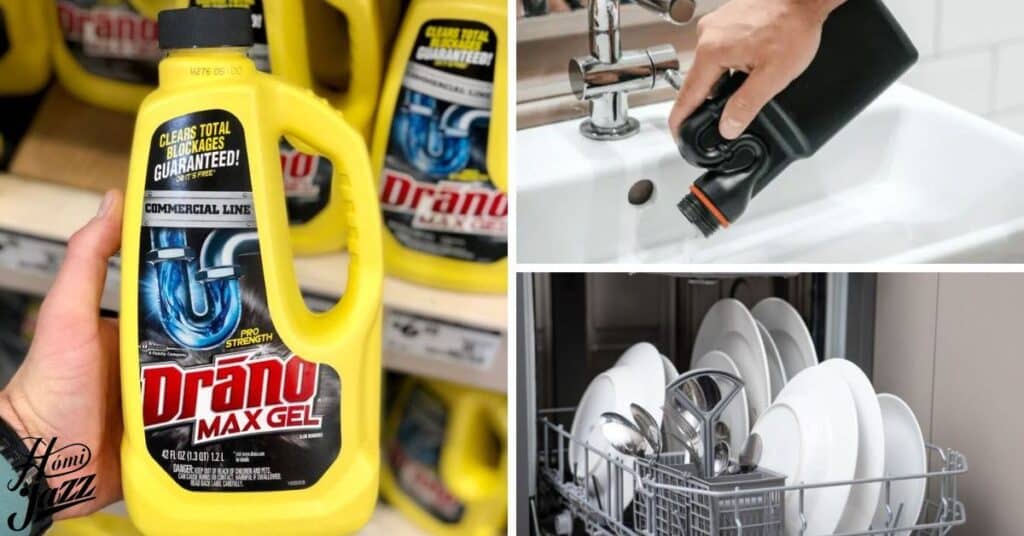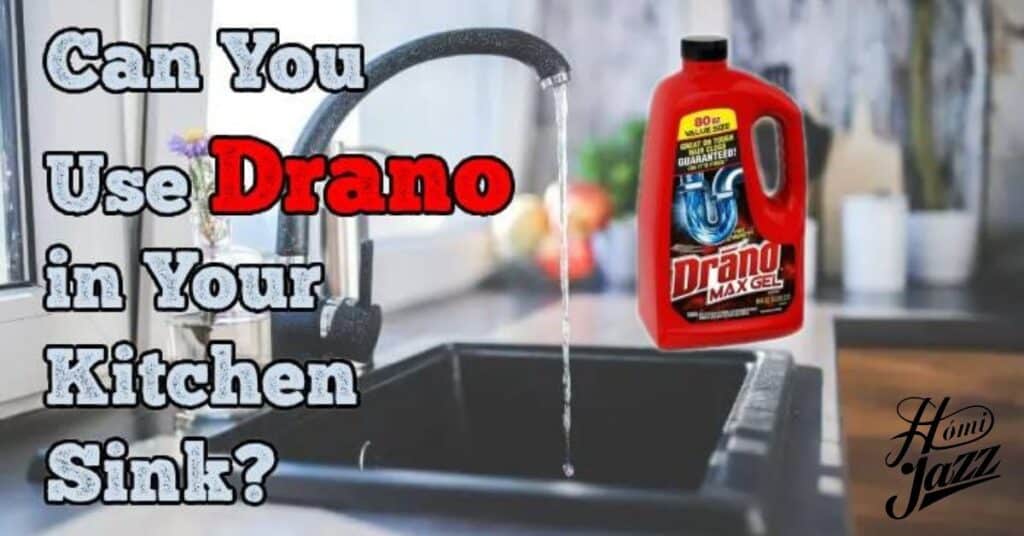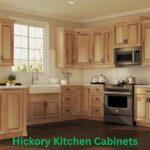It is a popular brand of drain cleaner known for its effectiveness in removing blockages caused by food particles, grease, and other debris. Drano breaks down these substances to restore proper drainage in sinks and pipes.
Ever found yourself facing a stubbornly clogged kitchen sink pondering whether to reach for the Drano? Whether you can safely use Drano in the kitchen sink is more than just about convenience finding a quick solution to a common household headache. Dive into the depths of drain cleaning mysteries and uncover the truth behind using Drano in your kitchen sink.
Drano is a powerful drain cleaner commonly used in kitchen sinks to dissolve grease food particles and other blockages. Its chemical composition enables it to effectively restore proper drainage making it a popular choice for household maintenance.
Understanding Drano

Drano is a powerful chemical solution designed to tackle tough clogs in household drains. It works by utilizing a combination of ingredients that dissolve and break down common substances causing blockages such as hair grease and soap scum. When poured into a clogged drain Drano reacts with the blockage effectively liquefying it to restore proper drainage.
There are several types of Drano products available each formulated to address specific types of clogs. For instance Drano Max Gel is ideal for tackling stubborn clogs caused by hair and soap buildup while Drano Dual Force Foamer is effective against greasy clogs. Drano offers specialized products for toilets and septic systems providing a comprehensive solution for various plumbing issues.
Read this blog:http://HOW MUCH DOES A WASHING MACHINE WEIGH?
Potential Risks and Considerations
Using Drano comes with potential hazards primarily due to its strong chemical composition. Direct contact with skin or eyes can cause irritation or burns so it is crucial to handle it with care. Inhaling Drano fumes can lead to respiratory issues making proper ventilation essential when using it in confined spaces.
When using Drano in kitchen sinks it is essential to take precautions to minimize risks. Always wear protective gloves and eyewear to shield yourself from potential contact with the chemical. Ensure adequate ventilation in the area to prevent inhalation of harmful fumes. Lastly carefully follow the instructions on the product label and never mix Drano with other chemicals as it can result in dangerous reactions.
Alternatives to Drano

When facing a clogged kitchen sink there are alternative methods to consider besides using Drano. One common DIY solution is using a mixture of baking soda and vinegar which creates a bubbling reaction that can help break down minor clogs. Another option is using a plumbing snake or auger to physically remove the blockage from the drain pipes.
Stubborn clogs or those that require professional expertise hiring a plumber may be necessary. Professional plumbers have access to specialized tools and equipment such as hydro jetting machines which can effectively clear even the toughest clogs. DIY solutions are cost effective and convenient for minor issues professional plumbing services offer a comprehensive solution for more challenging problems.
Read this blog also: http://WHY IS MY SWIFFER WETJET NOT SPRAYING?
Tips for Preventing Kitchen Sink Clogs
To prevent kitchen sink clogs ensure only small amounts of food are disposed of at a time avoiding fibrous or starchy items. Here are some simple and easy tips to prevent Kitchen sink clogs.
Dispose of Food Scraps Properly
- Avoid pouring grease oil or large food scraps down the drain.
- Use a sink strainer to catch food particles and empty it regularly.
Run Hot Water Regularly
- Run hot water down the drain after each use to help dissolve grease and prevent buildup.
- Consider pouring boiling water down the drain once a week to further prevent clogs.
Use Enzyme-Based Drain Cleaners
- Occasionally use enzyme based drain cleaners to break down organic matter in the pipes.
- These cleaners are safer for the environment and less harsh on your plumbing compared to chemical alternatives.
Regular Maintenance
- Schedule routine maintenance for your kitchen sink and plumbing system to catch any potential issues early.
- Inspect pipes for leaks or signs of corrosion and address them promptly to prevent clogs caused by pipe damage.
Avoid Overloading the Garbage Disposa
- Only dispose of small amounts of food at a time to prevent overloading the garbage disposal.
- Avoid putting fibrous or starchy foods like potato peels celery or pasta down the disposal as they can cause clogs.
Clean the Garbage Disposal Regularly
- Clean the garbage disposal blades and housing with a mixture of ice cubes and salt to remove debris and odors.
- Follow up with a flush of cold water to ensure everything is flushed away.
Educate Household Members
- Teach everyone in your household about proper kitchen sink etiquette to prevent clogs.
- Encourage them to follow the above tips and avoid habits that could lead to clogged drains.
Step-by-Step Guide to Using Drano in the Kitchen Sink
Here is a simple guide to using Drano in your kitchen sink:
Prepare the Area
Before using Drano in the kitchen sink ensure the area is dry to prevent dilution. Remove any standing water from the sink using a cup or bowl. This step helps Drano to effectively penetrate the clog without interference.
Measure and Pour Drano
Carefully measure the recommended amount of Drano according to the products instructions. Slowly pour the Drano down the drain aiming to coat the inside of the pipe evenly. This ensures that Drano can effectively reach and dissolve the clog.
Wait for Action
Allow the Drano to work for the specified amount of time typically around 15 to 30 minutes. During this time avoid using the sink to ensure Drano can penetrate and break down the clog effectively. Patience is key as Drano works its magic to clear the blockage.
Flush with Hot Water
After the designated time flush the drain with hot water to clear away the dissolved debris. Turn on the hot water tap and let it run for a few minutes ensuring thorough rinsing of the pipes. This step helps to wash away any remaining residue and ensures the drain is clear and functioning properly.
Frequently Asked Questions
Which Drano is best for kitchen sink?
For greasy clogs without a disposal use Drano Kitchen Granules. For tough clogs or garbage disposals use Drano Max Gel.
What can you pour down a kitchen sink to unclog it?
Try boiling water first to melt grease clogs. If that fails pour baking soda down the drain followed by vinegar to fizz and loosen tougher clogs.
Why do plumbers say not to use Drano?
Plumbers dislike Drano because it can damage pipes with harsh chemicals and potentially worsen clogs if it can not fully dissolve them.
How do you unblock a kitchen sink?
Try plunging first to dislodge clogs. If that fails pour baking soda followed by vinegar for a fizzing reaction to break up tougher blockages.
When should you not use Drano?
Skip Drano if you have a clog in your toilet (ineffective) or suspect a deep clog (may not reach it and worsen the problem).
What liquid do plumbers use to unclog drains?
Plumbers typically rely on mechanical tools for tough clogs not liquids. They might use a plumbing snake to reach and break up the blockage or a hydro jet to blast it away with high pressure water.
Why you should never use baking soda and vinegar to unclog a drain?
Baking soda and vinegar won not tackle tough clogs and the fizzing reaction is weak in open pipes. It is better for light cleaning not heavy blockages.
Conclusion
While Drano can be used in some kitchen sinks it is not always the best option. Drano Kitchen Granules work for greasy clogs without a garbage disposal and Drano Max Gel tackles tougher clogs or those in garbage disposals. Drano is harsh chemicals can damage pipes and may not fully clear deep clogs potentially worsening the issue.
Consider safer methods first try a plunger for typical clogs or boiling water for grease. Baking soda and vinegar can help with light blockages but stronger solutions might be needed. If those fail call a plumber. Their mechanical tools like snakes or high pressure water jets are more effective for stubborn clogs and avoid the risks of chemical drain cleaners.

Howdy is behind this home blog, sharing personal stories, thoughts, and insights from daily life. I can dedicated to bringing you the latest trends, expert advice, and creative ideas to make your home the sanctuary you’ve always dreamed of. Whether you’re looking for DIY tips, home decor inspiration, home loans, rentals or renovations.







